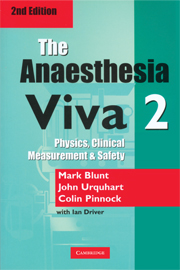Book contents
- Frontmatter
- Foreword to the First Edition
- Preface to the Second Editions
- Contents
- Physics, Clinical Measurement & Safety
- Clinical Anaesthesia
- Example 1
- Example 2
- 6 Example 3
- 7 Example 4
- Example 5
- Example 6
- Example 7
- Example 8
- Example 9
- Example 10
- Example 11
- Example 12
- Example 13
- Example 14
- Appendix 1
- Appendix 2
- Index
Example 9
Published online by Cambridge University Press: 05 February 2015
- Frontmatter
- Foreword to the First Edition
- Preface to the Second Editions
- Contents
- Physics, Clinical Measurement & Safety
- Clinical Anaesthesia
- Example 1
- Example 2
- 6 Example 3
- 7 Example 4
- Example 5
- Example 6
- Example 7
- Example 8
- Example 9
- Example 10
- Example 11
- Example 12
- Example 13
- Example 14
- Appendix 1
- Appendix 2
- Index
Summary
Scenario
You are called to see an 18-year-old motorcyclist in A & E. He has been involved in an RTA and has obvious deformity of his right thigh and a scalp wound. How do you proceed?
ABC first – as always. A quick estimation of the GCS and action as appropriate. You are told that he is alert, in pain and can move all four limbs. The immediate course of action is therefore:
▪ Oxygen by face mask
▪ Assess cervical spine
▪ Caridovascular monitoring
▪ Fluid resuscitation (assume fractured femur)
▪ Assess blood loss from scalp
▪ Pain relief – consider femoral nerve block
▪ Bloods and X-rays appropriate to the results of primary survey
It is most likely that you will directed to choosing an appropriate technique for taking the patient to theatre for nailing of his femur. Rapid sequence induction followed by IPPV with volatile and opioid (maybe femoral block) is appropriate. Beware pneumothorax and hidden abdominal bleeding in any trauma scenario. Discuss the blood loss element with respect to adequate resuscitation pre-induction. Discuss the head-injury aspect, although this is not significant in the facts as given above.
Often this scenario leads onto a related critical incident. Occasionally, it is complicated by the fact that the victim has had breakfast and long acting insulin one hour prior to the accident.
- Type
- Chapter
- Information
- The Anaesthesia Viva , pp. 109 - 111Publisher: Cambridge University PressPrint publication year: 2003



